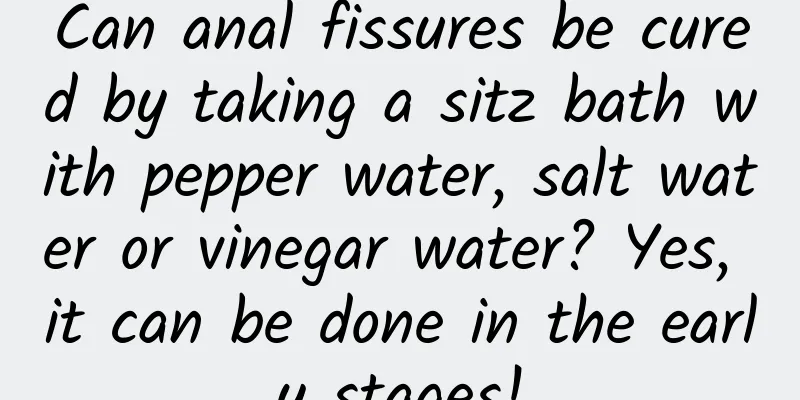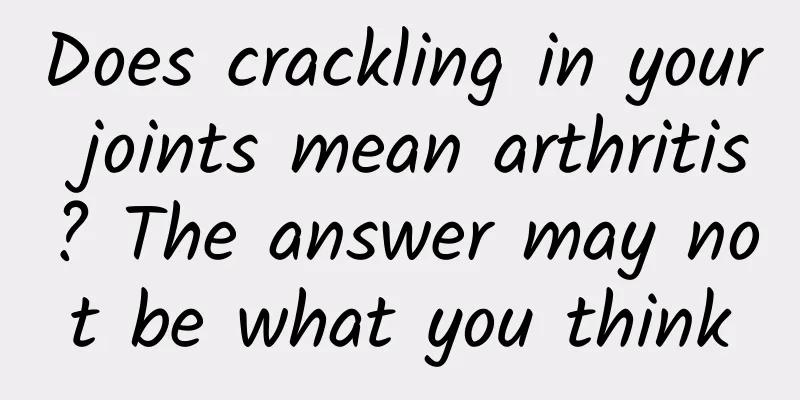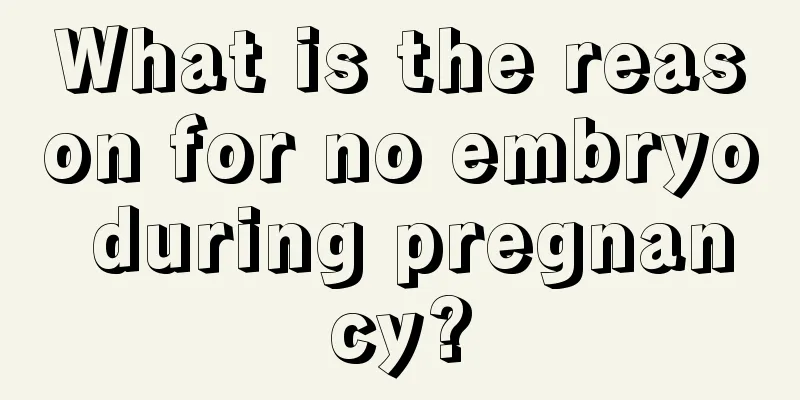Can anal fissures be cured by taking a sitz bath with pepper water, salt water or vinegar water? Yes, it can be done in the early stages!

|
Author: Wang Zhenbiao, Chief Physician, Beijing Century Altar Hospital, Capital Medical University Reviewer: Fan Xueshun, Chief Physician, China-Japan Friendship Hospital Many people think that anal fissure is not a serious disease and that a few drops of bleeding are nothing to be afraid of. Therefore, they do not pay attention to it in the early stages and do not actively treat it. In fact, the treatment of early anal fissure is very simple. You can take a sitz bath with warm water, pepper water, salt water, vinegar and boiled water, or go to the hospital and the doctor will prescribe some anti-inflammatory and analgesic ointments or suppositories, and it will heal quickly. If it is not treated actively in the early stage and further develops into chronic anal fissure, combined with sentinel hemorrhoids, hypertrophy of anal papillae, anal fistula, anal cryptitis, anal fissure triad or pentad, surgical treatment is necessary. So don't take anal fissure lightly. 1. How is anal fissure formed? Anal fissure is a full-thickness crack in the skin of the anal canal below the dentate line, forming an ulcer. Figure 1 Original copyright image, no permission to reprint From the perspective of traditional Chinese medicine, one is that heat can relieve intestinal dryness, such as eating spicy or irritating foods, or smoked, grilled, or fried foods, which gather moisture and generate heat, which are excreted from the intestines. The dampness and heat go down and cause constipation, leading to local anal tearing. The second is that qi and yin deficiency leads to constipation, and then anal fissures occur. From the perspective of modern medicine, the anus is surrounded by the internal sphincter and the subcutaneous part of the external sphincter. There is a sacrococcygeal triangle on the front and back sides and the back in the coccyx area. It is a hollow area, and the front perineum area is also a hollow area. These two areas are often susceptible to gravity impact during defecation and are prone to tearing. In addition, the internal sphincter is circular and has the functions of contraction and relaxation. If constipation occurs in a spasmodic state, it is easy to cause lacerations, usually mainly anterior and posterior ruptures. There is also the factor of infection. In the six and twelve o'clock area in front and behind the anus, there are more anal glands in the posterior anal recesses, accounting for more than one-third. This area is prone to infection. After bacteria and microorganisms enter, they block the openings of the anal glands and extend downward along the subcutaneous and muscle layers to form shallow abscesses. After rupture, ulcers are formed, forming anal fissures. If the ulcers do not heal for a long time, anal fistulas will form. Then there is the issue of blood circulation. There are two anatomical empty areas before and after the anus. The blood circulation in this area is relatively weak, which can easily cause tearing under the action of external force. 2. What are the symptoms and dangers of anal fissure? There are three main symptoms of anal fissure. First, pain. Second, bleeding. The amount of bleeding is usually not large, with toilet paper stained with blood or dripping with blood. Third, constipation. There are also some accompanying symptoms, such as local itching of the anus. Anal fissures can cause pain. Sudden tearing during defecation will cause pain, and then the pain will ease for a few seconds or one or two minutes. Soon, severe pain will occur and last for dozens of minutes or even several hours. It is very painful and generally unbearable, which seriously affects the quality of life. Figure 2 Original copyright image, no permission to reprint Anal fissure in the early stage is an ulcer, which is generally superficial, regular and soft. It will further develop into sentinel piles, combined with hypertrophy and prolapse of anal papillae, and even infection of anal crypts, forming anal fistulas. The combination of sentinel piles and anal papilloma is called anal fissure triad; anal crypt infection forms abscesses and anal fistulas, which is called anal fissure pentad, which is a chronic anal fissure. 3. How to treat anal fissure? The treatment of anal fissure and hemorrhoids is basically the same, and conservative treatment is the mainstay. In the early stage of newly developed anal fissures, relatively small sentinel piles or small papilloma are formed. The patient's requirements are not very high. They do not require anatomical perfection, but only require the elimination of symptoms and pain. In this case, conservative treatment is mainly used. The main cause of anal fissure is constipation. First of all, keep the stool smooth. If the stool is dry, soften it. If the stool is thick, soften it to make it thinner. When the anus is uncomfortable, wash it with hot water or cover it with a hot towel, and it will feel comfortable; Traditional Chinese medicine sitz bath, such as pepper water, salt water, vinegar water; Cnidium monnieri powder, Sanhuang powder, if the compatibility is correct, several medicines are decocted together, and fumigated and sitz bathed, which can also have a relieving effect through the effect of heat; Local hemorrhoid suppositories can reduce inflammation and relieve pain, promote wound healing, and there are also some ointments for external application; Closure therapy, using botulinum toxin to seal the wound, can promote wound healing after injection; Anal dilation therapy: if you find that the anus is loose, you can naturally dilate it to relieve sphincter spasm and relieve symptoms. Physical therapy, now with lasers and microwaves, can promote local healing and is non-invasive; Apply nitroglycerin topically. Nitroglycerin is a drug that relieves angina pectoris. It can relieve sphincter spasms after topical application. It is very effective in treating sphincter spasm type anal fissures. It should be noted that if the blood pressure is low, the use of drugs such as nitroglycerin may cause circulation problems while treating the disease, leading to a sudden drop in blood pressure and heart accidents, so be careful. Anal fissures are mostly treated conservatively, such as fumigation, sitz baths, local embolization, and application of medicines. Some drugs that improve microcirculation and local blood circulation can heal the wound. The results are very good and most of them do not require surgery. However, if these standardized treatments are not effective, or if the disease becomes chronic after several courses of treatment, generally three months, surgical treatment may be required. |
>>: Metal, ceramic, invisible... There are so many types of dental braces, how should you choose?
Recommend
Why is there bleeding again after a few days of menstruation?
Menstruation refers to the shedding of the endome...
Cervical cancer vaccination
This past January was Cervical Cancer Awareness D...
The best time to breathe oxygen during late pregnancy
CO2 is a necessity for us humans to live in the w...
Pregnancy with gestational sac but no fetal teeth and fetal heart
For those women in early pregnancy, the moment th...
Endometriosis should be treated early with Chinese medicine!
Endometriosis is caused by the growth of the endo...
What to do if you have blisters on your mouth during pregnancy
Pregnancy itself will cause disorders in the fema...
Symptoms from ovulation to pregnancy
I believe that anyone who has a certain understan...
8 Misuses of Sanitary Napkins
Sanitary napkins are indispensable items in women...
What should I do if I have allergies during confinement?
Mothers are very weak during the confinement peri...
What are the benefits of eating strawberries for pregnant women
The nutritional value of strawberries is relative...
What are the treatments for atypical endometrial hyperplasia?
We all know that the uterus is very important for...
Stock up! Be careful with COVID-19 medications...
Audit expert: Wu Xinsheng Deputy Chief Physician,...
Why is the leucorrhea milky white and has a fishy smell?
Abnormal leucorrhea is a health problem that wome...
Causes of atypical breast hyperplasia
Many female friends bring great health risks to t...
What is the difference between green shrimp and red shrimp? Which one is more delicious?
Fresh shrimps are tender and delicious, rich in n...









